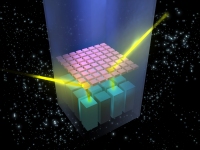Detecting Gamma-ray Bursts outside INTEGRAL's Field of View
19 June 2006
Making use of the double detector layer design of the IBIS instrument on-board INTEGRAL, a team of European astronomers have proved it possible to observe powerful gamma-ray bursts even if they fall outside the telescope's field of view.INTEGRAL can detect gamma-ray bursts (GRBs) in two different ways:
- When an event occurs in the field of view (FoV) of IBIS (Imager on-Board INTEGRAL Satellite), the position on the sky can be determined to within ~2 arcmin
- The larger number of GRBs that occur outside of the FoV can be monitored by the SPI anti-coincidence system, SPI-ACS. Localization of these bursts, however, was only possible with the third Interplanteray Network (IPN), which can triangulate GRB positions by making use of gamma-ray detectors on-board different spacecraft including Ulysses, Mars Odyssey and Wind.
New results presented by Dr Radoslaw Marcinkowski et al, show that for some of the bursts that occur outside INTEGRAL's FoV, it is now also possible to provide a localisation of a GRB by using the Compton mode of IBIS (Imager on-Board INTEGRAL Satellite) alone.
IBIS in Compton Mode
 |
|
Artist's impression of hard gamma-ray passing through IBIS |
The IBIS telescope is an imaging instrument on-board the INTEGRAL satellite with a codedmask. Most gamma-ray telescopes contain just a single detector layer, but IBIS has two detector layers separated by 94 mm. The top layer (ISGRI) is an array (128 × 128) of pixels made of semiconductive CdTe, sensitive in the energy range 15 keV, ~1 MeV. The bottom layer (PICsIT) is an array (64 × 64) of CsI scintillators, and can detect photons with energies between ~170 keV, 15 MeV.
When used as a Compton telescope, higher energy gamma rays trigger the first detector layer ISGRI and compton scatter through an angle θC, losing some energy in the process, but they are not completely absorbed. The deflected and less energetic gamma rays then pass through to the second layer PICsIT where they can be captured.
The direction of the source of the hard photons can be determined from the following information:
- energy deposited in ISGRI (EI) and PICsIT (EP)
- position of the detection in ISGRI (xI, yI) and PICsIT (xP, yP)
- timing of the event
The two positions on the detector layers provide the information about the direction of the scattered photon. The two measured energies provide the Compton scatter angle θC, the cosine of which, in case of the forward scatter, is given by:
cos θC = 1 - mec2/EI + mec2/(EI + EP)
where mec2 is the electron rest energy. Each photon can now be traced back to a ring on the sky, centred around the primary photon direction, with a cone angle of θC around that direction. The ring represents the possible directions from which the primary photon originated. If the source of the radiation is a point source, the back-projected rings of all detected photons will cross at the position of the point source on the sky.
GRB 030406
Hard photons coming from outside IBIS's FoV, but with high enough energy (E > 200 keV) to penetrate the lead wall of the telescope collimator, can still be observed in Compton mode, as the photons scatter off the one layer and are detected in the second. The Compton mode is sensitive to the energy range between 200 keV and ~5MeV.
A powerful Gamma-Ray Burst, GRB 030406, occured on 6 April 2003 and lasted around 65 seconds. At the time, INTEGRAL was pointed 36.9° away from the direction of the burst. Nevertheless Dr Radoslaw Marcinkowski, Space Research Center, Warsaw, Poland, and colleagues have reconstructed an image of the event using the radiation that passed through the side of INTEGRAL's imaging telescope.
Marcinkowski had heard of INTEGRAL registering a solar flare in this way even though the satellite wasn't pointing at the Sun. He thought that if it worked with solar flares, it must work with the most powerful GRBs. His hunch was proved correct, as INTEGRAL was able to provide an accurate location for GRB 030406.
Until now, the science teams have been forced to rely on luck that the satellite was pointing in the right direction at the right time. At present, they image about one a month. The Compton scattering technique could raise the number of INTEGRAL catches by 50 percent, and result in the imaging of between 2 and 5 more bursts per year.
The team now hope to fully automate the analysis routine that recognises the signals and localises them. This would mean that the software could run automatically at the INTEGRAL Science Data Centre (ISDC) in Geneva, Switzerland and automatically alert astronomers to its gamma-ray catches when they occur.
"GRB 030406 - an extremely hard burst outside of the INTEGRAL field of view", R. Marcinkowski et al. (2006), A&A 452, 113-117, doi: 10.1051/0004-6361:20064811
Contact
Radoslaw Marcinkowski
Space Research Center, Warsaw, Poland
E-mail: radek cbk.waw.pl
cbk.waw.pl
Christoph Winkler
ESA INTEGRAL Project Scientist
E-mail: christoph.winkler esa.int
esa.int

